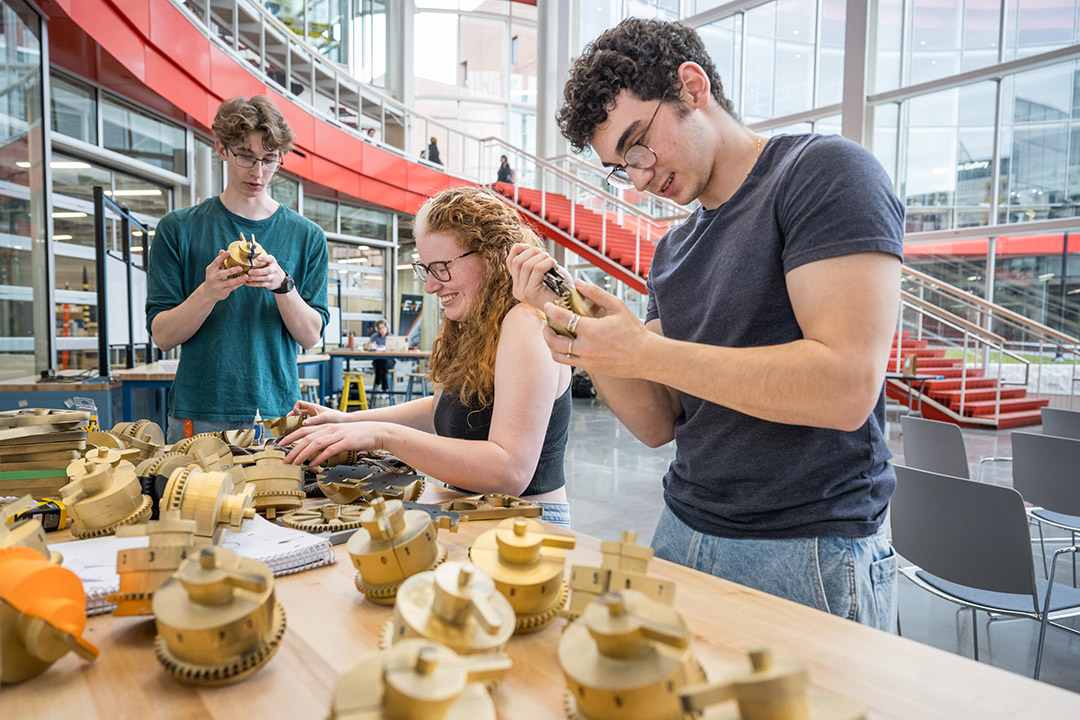RIT student and stage manager helps bring ‘Ada and the Engine’ to life April 4-7
Traci Westcott/RIT
RIT student Catherine Hampp, center, assembles a stage prop for Ada and the Engine consisting of more than 100 3D printed parts made in the SHED. Her friends and RIT students Jack Smith, left, and Bailey Brown lend a hand.
RIT student Catherine Hampp is one of the stars behind the scenes of Ada and the Engine—the first play to debut in the Sklarsky Glass Box Theater in the SHED, April 4-7.
Hampp, a fourth-year mechanical engineering major from Binghamton, N.Y., is the stage manager for the RIT School of Performing Arts’ production. She also built the central prop with moving parts to represent a 19th century calculator. The device, called a “difference engine,” is integral to Lauren Gunderson’s play, which pays homage to Ada Byron Lovelace, one of the first computer programmers.
The real-life Lovelace, a brilliant mathematician and daughter of Lord Byron, was friends with the inventor Charles Babbage, whose ideas were ahead of his time. He designed but never fully built either his difference engine or his early computer, dubbed an “analytical engine.” Nevertheless, Lovelace grasped potential applications of the proposed technology and published notes describing how the analytical engine might solve complex mathematics and even play music.
‘Ada and the Engine’ runs April 4-7
The RIT School of Performing Arts presents Ada and the Engine, written by Lauren Gunderson. Show times are 7:30-9:30 p.m. April 4-7, in the Sklarsky Glass Box Theater in the SHED. Admission is $5 for students; $10 for faculty, staff, and alumni; and $12 for the general public. Tickets can be purchased at RITtickets.com. For more information, contact peformingarts@rit.edu.
Hampp studied replicas of Babbage’s difference engine to create a facsimile of his early calculator. She used 3D printers in the SHED to make the moving gears and components of her machine.
The SHED is a multi-use complex that situates maker spaces next to performing arts facilities, and enables busy students like Hampp to design, construct, and use their creations under one roof.
“A lot of the difference engine is being 3D printed at the maker space, which is really convenient because I’ll go to rehearsal (in the Sklarsky Glass Box Theater), print stuff out then and pick it up at the maker space,” said Hampp, an RIT Performing Arts Scholar and theatre arts minor who plays the steel drums.
The ease of 3D printing the calculator parts isn’t lost on Hampp, especially when technological and financial limitations prevented Babbage from capitalizing on his ideas. His frustration forms a storyline in the play.
“In terms of the plot, Ada meets Charles Babbage where he is displaying his difference engine model, and the two of them ‘geek out’ over this model and talk about potential other possibilities,” Hampp said.
Hammp resonated with Lovelace on a personal level. “I think arts and science are not as separate as people think,” she said. “I really love the way her mindset is and how she sees them in the same way.”
A self-described “theater geek,” Hampp has worked in stage management since high school and during her four years at RIT. One of the reasons she chose RIT, she said, was to combine a technical degree with a theater arts minor.
Last summer, Hampp worked as an intern in the Broadway division at Production Resource Group (PRG), a company that creates set designs and staging solutions for live entertainment. Since then, she has continued to work for PRG part-time and has completed projects this school year.
While Ada and the Engine will be her final role as a stage manager of an RIT production, Hampp is not done with the stage. After graduation, she will go to Boston University for an MFA in technical production.
“I really want to combine mechanical design and theater,” Hampp said. “I want to be the person who takes the designs from the scenic designer and figures out how to construct and build set designs on Broadway and for tours and concerts.”












